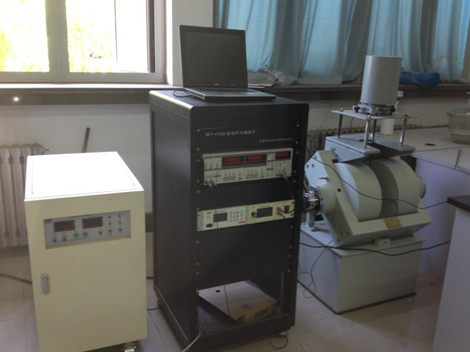产品:Magnetic testing
Detailed
Detailed consultation with customer service
Magnetization curve
The magnetization curve is the relationship between the magnetic field intensity H in the substance and the induced magnetic induction intensity B or the magnetization intensity M.
The vibrating sample magnetometer can detect the intrinsic magnetic properties of various substances (materials), such as magnetization MS (σ s), Curie temperature Tc, coercive force HC, remanence Mr, etc. Other technical parameters such as BS, Br, (BH) max and permeability (including initial permeability) can be obtained indirectly. The magnetic properties of the tested sample can be determined according to the characteristics of the loop. It can draw hysteresis loop, permeability curve, initial magnetization curve, demagnetization curve, thermal magnetic curve, etc. DC magnetoelectricity of measuring materials
Resistance characteristics. The samples can be powder, particle, film, liquid, block and other magnetic materials.
Main specifications and technical indicators
1. There are 27 options from 2nv to 1V, and 14 options from 10 μ s to 30s
2. The magnetic moment measurement range of the instrument is 10-3emu-100emu, and the highest sensitivity is better than 5 × 10-5emu
3. The relative accuracy is better than ± 1% (when the measuring range is 10emu), and the repeatability is better than ± 1% (when the measuring range is 30emu)
4. Variation range of magnetic field strength: 0 ~ 2.0T (without variable temperature furnace, the gap between magnetic poles is 40mm) or 0 ~ 1.8T (with variable temperature furnace, the gap between magnetic poles is 50mm), step accuracy is 1 OE (in small field)
5. Stability (when measuring range is 10emu): preheat for 1 hour, and work continuously for 24 hours is better than 1%
6. Temperature range: continuous change from liquid nitrogen temperature range to 500 ℃
7. Measurement range of magnetoresistance: 1 μ Ω ~ 3M Ω; accuracy: 1 μ Ω
Hysteresis loop
In a magnetic field, the relationship between the magnetic induction intensity and the magnetic field intensity of a ferromagnet can be represented by a curve. When the magnetic field changes periodically, the relationship between the magnetic induction intensity and the magnetic field intensity in a ferromagnet is a closed line, which is called a hysteresis loop. The area of B-H hysteresis loop represents the energy loss of ferromagnet after a cycle.
Demagnetization curve
Commonly used flux density B, magnetic polarization intensity, or magnetization m with the external magnetic field intensity h reverse monotonic change relationship B-H, J-H or M-H curve. The demagnetization curve describes the previous stage of the demagnetization process, which starts from the residual magnetization MR and ends at zero.
Curie point
Curie point, also known as Curie temperature or magnetic transition point, refers to the temperature that can be changed between ferromagnetic and paramagnetic materials, that is, the transition temperature of ferroelectrics from ferroelectric phase to paramagnetic phase. It can also be said to be the transition temperature of the first-order phase transformation.
Magnetoresistance
Magnetic materials with significant magnetoresistance effect are called magnetoresistance materials. The so-called magnetoresistance effect refers to the change of resistance value when a magnetic field is applied to an electrified metal or semiconductor.
magnetostrictive coefficient
Magnetostriction refers to the change of the size of ferromagnetic materials in all directions due to the change of magnetization. Under the action of external magnetic field, the size of ferromagnetic material extends (or shortens). After removing the external magnetic field, it returns to its original length. This phenomenon is called magnetostriction phenomenon (or effect). Magnetostrictive effect can be described by magnetostrictive coefficient λ (or strain).
DC magnetic properties of soft magnetic materials
Magnetic materials can be divided into soft magnetic materials and hard magnetic materials according to the difficulty of demagnetization after magnetization. Soft magnetic material refers to the magnetic material with coercive force HC ≤ 1000A / m, mainly including low carbon steel, silicon steel sheet, ferronickel alloy, some ferrite materials, etc.
Permeability
Permeability is the ratio of B to h corresponding to any point on the hysteresis loop, which is closely related to the working state of the device.
Coercive force
Coercive force is a quantity indicating the difficulty of magnetization of materials, which depends on the composition of materials and defects (impurities, stress, etc.).
Residual magnetic induction
The residual magnetic induction intensity is the characteristic parameter on the hysteresis loop, and the b value when h returns to 0.
| Warm tip: the products supplied by Beijing Beike Xincai Technology Co., Ltd. are only used for scientific research, not for human body |
| Item ID | Info |
| BK2020011602-01 | CAS: ID:BK2020011602 Pack: Parameter:磁化曲线 Stock:100 Make up: Price:$0 |
| BK2020011602-02 | CAS: ID:BK2020011602 Pack: Parameter:磁滞回线 Stock:100 Make up: Price:$0 |
| BK2020011602-03 | CAS: ID:BK2020011602 Pack: Parameter:退磁曲线 Stock:100 Make up: Price:$0 |
| BK2020011602-04 | CAS: ID:BK2020011602 Pack: Parameter:居里点 Stock:100 Make up: Price:$0 |
| BK2020011602-05 | CAS: ID:BK2020011602 Pack: Parameter:磁电阻率 Stock:100 Make up: Price:$0 |
| BK20200116020-06 | CAS: ID:BK2020011602 Pack: Parameter:磁致伸缩系数 Stock:100 Make up: Price:$0 |
| BK2020011602-07 | CAS: ID:BK2020011602 Pack: Parameter:软磁材料直流磁特性 Stock:100 Make up: Price:$0 |
| BK2020011602-08 | CAS: ID:BK2020011602 Pack: Parameter:磁导率 Stock:100 Make up: Price:$0 |
| BK2020011602-09 | CAS: ID:BK2020011602 Pack: Parameter:矫顽力 Stock:100 Make up: Price:$0 |
| BK2020011602-10 | CAS: ID:BK2020011602 Pack: Parameter:剩余磁感应强度 Stock:100 Make up: Price:$0 |
- Previous: Electrical test
- Next: ITOConductive glass su


 Material testing and consumables
Material testing and consumables
